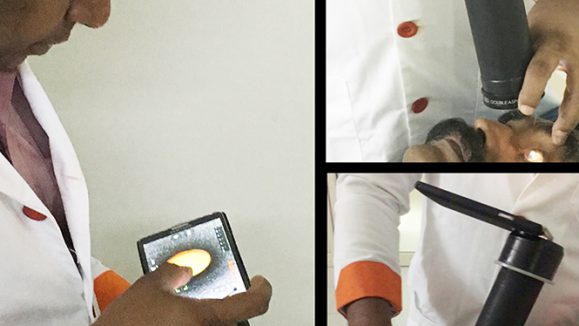One thing is certain: Biosimilars have got people talking. And at conferences taking place this year, discussion on biosimilar anti-VEGF agents and how both patients and ophthalmic professionals could benefit was commonplace.
Excitement about anti-VEGF biosimilars is similarly apparent in academic research and reviews. So, what are ophthalmology’s best and brightest saying about these new agents? We dive in below . . .
Anti-VEGF Usage
Anti-VEGF (anti-vascular endothelial growth factor) agents are designed to reduce the growth of new blood vessels and swelling in the eye. They are commonly used to treat a variety of conditions, including wet age-related macular degeneration (nAMD), diabetic macular edema (DME) and retinal vein occlusion (RVO).
Anti-VEGFs and their manufacturers are frequently criticized for their cost, which is high enough to make them prohibitively expensive around the world. For example, one 2mg dose of aflibercept can cost $1,850 in some countries, putting it out of reach for many patients.1
At a time when the pharmaceutical industry has been targeted over high costs, it’s unsurprising that researchers are looking for alternatives.
Biosimilars: Nearly the Same
Biosimilars are similar to generic drugs. However, the key difference is that generics are the same medicines as their equivalent brand names, while biosimilars are different drugs. They are remarkably similar to their analog, and subject to strict quality control, but they are not the same.
This is because the molecules of biosimilars are considerably more complex than those that comprise generic drugs, which are created via chemical reactions. Biosimilar molecules are 100 to 1,000 fold times larger than small molecule drugs like generics.2
Proponents of expanding the use of biosimilar anti-VEGFs point to their reduced production costs without compromising on quality or efficacy. As the U.S. patents for ranibizumab and aflibercept, two of the most common anti-VEGFs expire this year, a window of opportunity is opening.
What’s Seven Years Versus Three?
One of the foremost studies on anti-VEGF biosimilars was published in 2018 by a group of researchers, including Dr. Ashish Sharma. He recently addressed the safety of Razumab, a biosimilar of ranibizumab at the Annual Meeting of the All India Ophthalmological Society (AIOC 2020).
Dr. Sharma stated that it took seven years for ranibizumab’s incidence rate to drop from 0.7 to 0%, where Razumab achieved this drop in just three years.
The study, “Biosimilars in Ophthalmology: “Is there a big change on the horizon?” drew on research from universities in India, Israel, the U.S. and other countries, and concluded that biosimilars were poised to revolutionize ophthalmology. The study also alluded to biosimilar potential in developing markets, due to lower manufacturing costs and the fact that drugs like bevacizumab have faced temporary bans by regulatory agencies. Biosimilars could take over while these bans are in effect.3
Biosimilars to Target Wet AMD
Published online just last December, the “Multicenter Retrospective Study (RE-ENACT 2) on the Use of Razumab in Wet AMD”4 was a comprehensive examination on using biosimilars as frontline medicine. According to the study, wet AMD causes 1.7 to 3.3% of blindness cases in India.
Patients were treated over three years at 17 centers across India; 62.1% were men and 74.8% were treatment naive. A majority of the study’s patients (57.9%) received ranibizumab injections, with most receiving three. The authors reported significant improvements in best corrected visual acuity (baseline, 0.92 ± 0.6 [n = 94]; week 48, 0.51 ± 0.4 [n = 14]; P = 0.0014) and central subfield thickness (baseline, 430.83 ± 14.4 [n = 85]; week 48, 301.26 ± 11.6 [n = 15]; P < 0.0001). Intraocular pressure changes were minimal and not significant.
The study concluded that the treatment was broadly successful with demonstrated improvements in visual acuity and disease outcomes. Furthermore, the treatment remained effective up to a year after it began and changes in intraocular pressure were minimal.
The study’s conclusions have fueled excitement on the potential of biosimilars in ophthalmology, exemplified by Dr. Sharma’s talk at AIOC 2020.
Limitless Potential or Potential Limitations?
While recognizing that biosimilars offer considerable potential in lowering financial barriers to medicine, Prof. Bruce N. Cronstein from New York University says that the large size of biosimilar molecules is problematic. Speaking to the Journal of Hematology & Oncology, Prof. Cronstein said that modifications could occur during the manufacturing process that are undetectable, which could lead to altered efficacy and immunogenicity.5
And according to Drs. Szilard Kiss and Jennifer Krawitz, both from Weill Medical College of Cornell University, New York, the costs of producing biosimilars is still prohibitively expensive. They state that if ocular biosimilars follow the model of other biosimilars released in the U.S., savings of 15 to 30% off on ranibizumab biosimilars and others could be achieved. However, they say the final cost of biosimilars would still be too expensive and nowhere near as cheap as the cost of bevacizumab at $50 a dose.
In their paper “Coming of Age: Biosimilars,” the doctors also said that Razumab initially struggled to maintain quality control in India, where it is sold for $240 per dose. They noted that in the beginning,10% of patients reported ocular inflammation. Since the manufacturing process was corrected, no significant adverse effects have been reported.6
Biosimilars will have a major impact on ophthalmology, and as more patents expire in the coming decade, we are likely to see more biosimilars emerge. Whether or not they become an industry standard is unclear, but what is apparent is that discussion on their applicability and efficacy will continue well into the future.
References:
1. Stewart MW. Aflibercept (VEGF Trap-eye): the newest anti-VEGF drug. Br J Ophthalmol. 2012;96(9):1157-1158..
https://www.ncbi.nlm.nih.gov/pmc/articles/PMC3008392/
2. Tinsley SM, Grande C, Olson K, et al. Potential of Biosimilars to Increase Access to Biologics: Considerations for Advanced Practice Providers in Oncology. J Adv Pract Oncol. 2018; 9(7): 699–716.
https://www.ncbi.nlm.nih.gov/pmc/articles/PMC6570521/
3. Sharma A, Reddy P, Kuppermann BD, et al. Biosimilars in ophthalmology: “Is there a big change on the horizon?”, Clin Ophthalmol. 2018; 12: 2137–2143.
https://www.ncbi.nlm.nih.gov/pubmed/30498330
4. Sharma S, Khan M, Chaturvedi A; RE-ENACT 2 Study Investigators Group. A Multicenter, Retrospective Study (RE-ENACT 2) on the Use of Razumab™ (World’s First Biosimilar Ranibizumab) in Wet Age-Related Macular Degeneration. Ophthalmol Ther. 2020;9(1):103-114.
https://www.ncbi.nlm.nih.gov/pubmed/31883056
5. Bruce N. Cronstein. The Benefits and Drawbacks of Biosimilars. (Mark J. Ratain, Interviewer). Retrieved from; https://www.hematologyandoncology.net/archives/october-2015/the-benefits-and-drawbacks-of-biosimilars.
6. Kiss S, Fine HF, Krawitz J. Coming of Age: Biosimilars. Ophthalmic Surg Lasers Imaging Retina. 2018;49(3):162-165.



